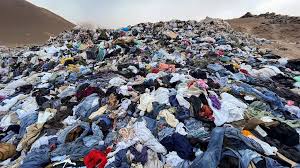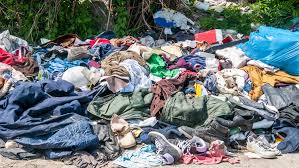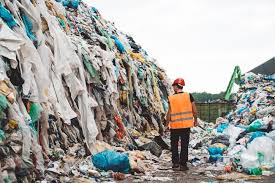Clothing waste refers to clothes that are thrown away or discarded, often because they are no longer wanted or usable. This can happen when people outgrow their clothes, they go out of style, or they become damaged. Clothing waste can have negative effects on the environment and is a result of our throwaway culture.
In our fast-paced, ever-changing world, it’s easy to forget about the hidden consequences of our fashion choices. We love shopping for new clothes, staying stylish, and keeping up with the latest trends. But what happens to all the clothes we no longer want? That’s where clothing waste comes in, a problem that’s often overlooked but carries a hefty toll on our environment and communities.
What is Clothing Waste?
Clothing waste is all the garments that are discarded and thrown away. This happens for various reasons: maybe your favorite shirt doesn’t fit anymore, or that trendy dress from last year is suddenly “out of fashion.” Regardless of the cause, clothing waste is a growing concern worldwide.
The Environmental Impact
When we toss out clothes, they often end up in landfills. These heaps of discarded textiles contribute to pollution, emitting harmful greenhouse gases like methane. Additionally, many fabrics take a long time to decompose, further damaging our environment.
The Human Cost
But it is not just the planet that suffers. Many of the clothes we discard are produced in low-wage countries, where workers may endure poor conditions and earn meager wages. When we buy more and discard quickly, it perpetuates this cycle of exploitation.
Read Also: Exploring the Benefits of Lightbulb Waste
Solutions for a Sustainable Future

1. Buy Less, Choose Wisely: Invest in clothing that lasts longer and transcends fleeting trends. Quality over quantity is key.
2. Second-Hand Shopping: Thrift stores, consignment shops, and online platforms for second-hand clothes can extend the life of garments.
3. Repair and Reuse: Instead of throwing away damaged clothes, consider repairing them or finding creative ways to give them new life.
4. Recycling: Explore textile recycling options in your area. Some organizations collect old clothes for recycling into new materials.
5. Support Ethical Brands: Seek out brands committed to ethical and sustainable production practices.
6. Educate and Raise Awareness: Share the importance of reducing clothing waste with friends and family to create a collective effort.
Clothing waste is a pressing issue that affects our environment and society in significant ways. By making conscious choices, we can reduce our contribution to this problem and work towards a more sustainable and responsible fashion industry.
The Importance of Clothing Waste
In our world of ever-changing fashion, it’s easy to forget about the clothes we no longer wear. But clothing waste is a bigger deal than it might seem. Let’s break down why it’s important in simple terms.
1. Environmental Impact: When we toss clothes into the garbage, they often end up in landfills. These massive heaps release harmful gasses, like methane, into the air, which can harm the environment and contribute to global warming.
Some fabrics take a very long time to break down in landfills, even hundreds of years. This means they keep causing problems for a very long time.
2. Resource Depletion: Producing clothes consumes a lot of valuable resources such as water, energy, and raw materials like cotton. When we throw clothes away quickly, it’s like throwing these resources in the trash.
Did you know that making one cotton t-shirt can take as much water as you’d drink in three years? Throwing away clothes means wasting water too.
3. Human Impact: Many of the clothes we buy are made in places where workers often face tough conditions and low pay. When we discard clothes rapidly, it can contribute to their struggles.
Clothing waste also hits our wallets. We spend money on new clothes only to toss them out after a short time. That’s like throwing away our hard-earned cash.
Overcoming the Issue
We can all do our part to reduce clothing waste:
1. Think Before You Buy: Ask yourself if you really need that new item. Will you wear it often, or is it just a passing trend? Choosing quality over quantity can make a difference.
2. Reuse and Share: If you no longer need a piece of clothing, consider giving it to someone who does or organizing clothing swaps with friends.
3. Learn Simple Repairs: Minor tears or damages don’t mean a piece of clothing is worthless. Learning to mend or repair clothes can extend their life and save you money.
4. Recycle or Upcycle: Look for recycling programs that turn old clothes into new things, or get creative and transform them into something unique.
5. Support Ethical Brands: Some clothing companies prioritize fair working conditions and sustainable practices. Supporting them with your purchases sends a message that these values matter.
Clothing waste isn’t a small issue, it’s a big one that affects our environment, society, and finances. By making conscious choices about what we buy and how we dispose of clothes, we can all play a part in reducing its impact. Let’s be mindful of our fashion choices and contribute to a healthier planet and fairer conditions for everyone.
Read Also: How to Dispose of Paper Waste Safely
A Fresh Perspective on Clothing Waste

Clothing waste is a complex issue, but new ideas and approaches are emerging to tackle it in creative ways. Let’s explore these fresh perspectives for a more sustainable future.
Circular Fashion
1. Renting and Borrowing: Instead of owning everything, we can rent clothes for special occasions or borrow from shared wardrobes. This reduces the need for buying new items.
2. Clothing Libraries: Imagine libraries filled with clothes you can borrow like books, allowing people to experiment with styles without long-term commitments.
Technology and Smart Fabrics
Tracking Clothing Lifecycles: Using technology like RFID tags, we can track a garment’s lifecycle, from production to disposal. This data can help brands make more sustainable choices. Innovations like self-cleaning fabrics and those that adjust to temperature changes can extend the lifespan of clothes.
Recycling and Upcycling
1. 3D Printing: This technology can transform old clothes into new items, reducing waste.
2. Microfiber Capture: Special filters in washing machines can capture tiny clothing fibers that usually end up polluting oceans.
Educational Initiatives
1. Sustainable Fashion Education: Teaching people about the impacts of clothing waste and how to make eco-conscious choices can lead to lasting change.
2. DIY Workshops: Workshops that teach repair and upcycling skills empower individuals to make the most of their clothes.
Regenerative Agriculture and Sustainable Materials
1. Plant-Based Fabrics: Using materials like hemp and bamboo for clothing reduces the environmental footprint.
2. Closed-Loop Production: Brands are exploring closed-loop systems where clothes can be remade into new ones, reducing waste and conserving resources.
Fashion Buybacks and Extended Producer Responsibility
1. Take-Back Programs: Brands are offering to buy back old clothes to recycle or resell, reducing waste.
2. Producers’ Responsibility: Encouraging fashion brands to take responsibility for the entire lifecycle of their products, from creation to disposal.
Local and Small-Scale Production
1. Local Manufacturing: Smaller, local brands often produce in smaller batches, reducing overproduction and waste.
2. Made-to-Order: Some companies make clothes only when a customer places an order, eliminating excess inventory.
Addressing clothing waste isn’t just about tossing less; it’s about reimagining the entire fashion industry. These innovative approaches offer hope for a more sustainable and responsible future where our love for fashion doesn’t come at the expense of the planet or people. By embracing these ideas and encouraging change, we can shape a brighter, more stylish tomorrow.

